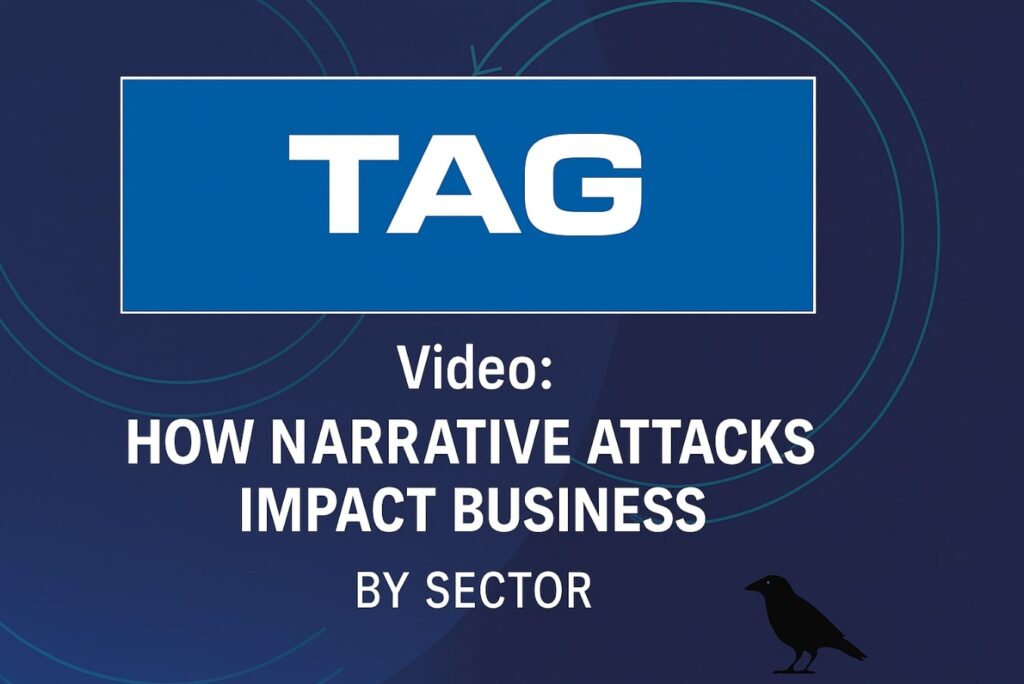TAG Infosphere: Narrative Attacks Now Threaten Every Major Business Sector
In a new Blackbird.AI video interview series, TAG Infosphere CEO Ed Amoroso and his analysts explain how narrative attacks disrupt industries, including cybersecurity, healthcare, telecom, insurance, finance, government, tech, and advertising. And what leaders can do to respond.

TAG Infosphere
Narrative attacks have evolved into a fundamental security threat that no major business sector can afford to ignore. These coordinated disinformation campaigns are designed to manipulate public opinion, destabilize organizations, and bypass traditional security controls by targeting human perception directly. In a new video interview series, cybersecurity veteran Ed Amoroso and TAG Infosphere sector analysts break down how these weaponized narratives are specifically designed to exploit vulnerabilities in industries ranging from financial services and healthcare to technology and government, offering an inside look at how this emerging threat vector requires a fundamental shift in security strategy.
LEARN: What Is Narrative Intelligence?
Through exclusive interviews with TAG Infosphere analysts, including founder Ed Amoroso, Blackbird.AI examines how these weaponized narratives specifically target vulnerabilities in eight critical sectors, from eroding patient trust in healthcare to manipulating financial markets and undermining technology innovation. These industry-specific insights reveal each industry’s unique risks and the emerging tools and strategies organizations deploy to detect, analyze, and counter narrative-based threats before they inflict lasting damage.
Cybersecurity: The Expanding Threat Surface
TAG Infosphere founder Ed Amoroso explains that traditional cybersecurity must now account for a new attack vector: weaponized information. “Narrative attacks have emerged as an urgent threat in cybersecurity,” Amoroso states in his interview. From AI-generated deepfakes to manipulated viral narratives, these attacks exploit human trust rather than technical vulnerabilities, destabilizing organizations from within.
The most insidious aspect of narrative attacks is how they bypass existing security controls. While organizations have invested heavily in protecting infrastructure, these narrative-based threats target human perception directly, leaving companies vulnerable despite robust technical defenses.
Technology: Innovation Under Siege
Former HP CISO Joanna Burkey reveals how technology companies face narrative attacks designed to undermine product safety, data privacy practices, and ethical standards. “This new threat vector can erode trust, destabilize organizations, and exploit cognitive vulnerabilities faster than traditional attacks,” Burkey explains in her interview.
Technology firms are particularly susceptible to narratives questioning their handling of user data or suggesting security flaws in their products. As Burkey discusses, these attacks often leverage technical complexity against companies, making it difficult for them to respond effectively before the narrative takes hold.
Insurance: Undermining Trust in Claims and Coverage
The insurance industry provides financial security for individuals and businesses, making it particularly vulnerable to narrative attacks that question its reliability. As Amoroso discusses, false narratives about an insurer denying legitimate claims or mishandling customer information can spread virally, undermining the fundamental trust relationship that drives insurance purchases.
Insurance products are essentially promises of future protection, and narrative attacks that question an insurer’s willingness or ability to fulfill those promises strike at the industry’s core value proposition.
Healthcare: Patient Trust at Risk
Former healthcare CISO John Rasmussen outlines how narrative attacks can have life-or-death consequences when they spread misinformation about treatments, medications, or healthcare providers. These attacks can range from undermining confidence in specific treatments to questioning the motives of healthcare organizations or professionals.
The stakes in healthcare are uniquely high, as narrative attacks can influence medical decisions and patient behaviors. Whether through false claims about treatment efficacy or misinformation about organizational practices, these narratives can lead to tangible harm for patients and providers alike.
Financial Services: Market Manipulation and Trust Erosion
The financial services sector faces unique narrative-based threats, including stock price manipulation through coordinated misinformation campaigns. According to Amoroso, banks and financial institutions must protect their digital assets and the trust relationships upon which their businesses are built.
Financial services firms are particularly vulnerable because trust forms the foundation of their business model. When false narratives about financial stability, executive actions, or regulatory compliance spread, they can trigger market moves and customer actions with real financial consequences—even when those narratives have no factual basis.
Advertising: Undermining Campaign Integrity
In the advertising sector, TAG analyst Shawn Hopkins explores how narrative attacks threaten the trust relationship between agencies and clients. False narratives about campaign effectiveness, audience metrics, or agency practices can quickly damage reputations in this highly competitive industry.
Advertising agencies face a particular challenge as their business model relies on demonstrating value through metrics that can be complex for clients to verify independently. Narrative attacks that question these metrics or suggest improper practices can rapidly undermine client confidence.
Telecommunications: Service Integrity Under Fire
For telecommunications providers, narrative attacks often target their reputation for service reliability and customer treatment. Amoroso notes that telecom companies operate in a space where service disruptions or customer dissatisfaction can quickly become amplified through coordinated narrative campaigns.
These companies face unique challenges because they provide the essential infrastructure that connects society. When narratives questioning a telecom provider’s network reliability, data privacy practices, or billing accuracy gain traction, they can rapidly erode customer confidence and market share.
Government and Public Sector: Public Trust Under Attack
TAG Infosphere analyst Iassen Christov examines how government entities must defend against narrative attacks designed to erode public trust in institutions. “The security of any nation depends on the trust of its citizenry,” Christov notes, highlighting why narrative intelligence has become essential for national security.
Government agencies face multifaceted threats, from election interference to coordinated campaigns questioning public health guidance. These narrative attacks don’t just target specific agencies; they undermine the broader foundation of trust in governance itself.
The Way Forward: Takeaways for Organization Leaders
Evolve Your Threat Model: Security and risk leaders must expand their security posture beyond technical controls to include narrative intelligence monitoring. Detecting and analyzing narrative-based threats requires new tools, skills, and partnerships.
Develop Rapid Response Capabilities: Early detection of emerging narrative attacks enables organizations to respond before they spiral out of control. Automated monitoring combined with strategic response planning provides the speed to counter today’s AI-accelerated narrative threats.
Build Narrative Resilience: Organizations must proactively strengthen their narrative foundation by understanding how they’re perceived across different stakeholder groups and developing the capability to assess and respond to narrative risks as they emerge quickly.
Narrative attacks will define organizational security challenges through 2025. Organizations implementing narrative intelligence now gain a competitive advantage while vulnerable competitors scramble reactively after attacks occur. Your security strategy must evolve today because threat actors already weaponize information against your industry. The question remains: Will you detect the narrative attack before it damages your organization?
- To receive a complimentary copy of The Forrester External Threat Intelligence Landscape 2025 Report, visit here.
- To learn more about how Blackbird.AI can help you in these situations, book a demo.
Need help protecting your organization?
Book a demo today to learn more about Blackbird.AI.



